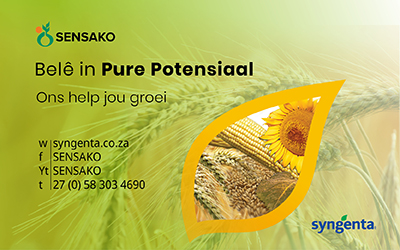
Humankind has created a range of crop species with the ability to produce phenomenal yields on small patches of land. This ‘creation’ is the result of hundreds of years of selection, hybridisation and lately genome editing to have a basket of plant cultivars that outperform their original mother stock by several orders of magnitude.
The attributes and shortcomings of modern crop cultivars
It is unthinkable that the wild maize (Zea mays) that was harvested by the ancient (but highly civilised) cultures of the Meso-Americas and is still growing wild there, will produce up to 12 tons of maize/ha, which is not unheard of with modern maize varieties. Plant breeders are very innovative and develop cultivars of food and fibre crops by practicing Darwinism: selecting the plants in a population that are most adaptable to certain environmental stressors such as drought, heat, cold temperatures and even certain crop pests and diseases.
The farming community owes these scientific gurus a huge debt for the highly productive cultivars that come to the market each year. Yet, producers are not overall winners, because despite the high yields and extremely valuable attributes that are received at the hands of the plant breeders, the plants lost their total adaptability of defence to a wide range of plant pests, diseases and weeds. The wild maize needs no human support to survive and thrive, but a modern, fast-growing maize cultivar needs a lot of support from its grower to survive the challenges thrown at us by Mother Nature. In brief it means that we have super crop cultivars but need to pamper them to achieve their promising yields.
A mind shift in crop production
The generation born in the mid-50s to late 60s will remember crop production as a series of standard events: ploughing (tilling), discing, planting, weeding, spraying against pests and diseases and hopefully, at the end of the season, harvesting a profitable crop. Our environmental consciousness only really came into being about two decades ago when the agricultural sector realised that we were planting and harvesting the agricultural landscape to death. The billowing dust clouds of the Free State and Northwest provinces became a bone of contention and triggered a total mind shift in producers.
Concepts of salination, acidification and compaction of soil became negative buzzwords and producers rapidly started looking at more environmentally compatible cultivation practices, so much so that tilling has virtually died out in favour of minimum till or no-till cultivation. There are a few minor challenges to this new way of cultivation, but the advantages for the producer outweigh the challenges significantly. Less than a decade ago, a new concept started rearing its head: soil health became the talk at the co-op and district agriculture union meetings with specialists and con artists (unfortunately) advocating that healthy plants need healthy soils. Although any modern producer grasps this concept easily, it must be considered how it fits into optimising crop yields.
Steer clear of the smooth talkers
Producers are often taken for fools by sales agents who promote soil additives with promises of massive yield increases. However, common sense dictates that it is impossible to increase crop yield by as much as 30% (that is what is promised by the con artists) with a soil conditioner. Producers are already sitting at near optimal yields on many farms, so how on earth will an organic acid that is added to the soil or a beneficial microbe that is inoculated into the soil boost the performance of the crop from 7 to 9 tons maize per hectare? That sounds all too much like alchemy to carry any value for the discerning producer. Rather sit down and think about effective crop production and work out the mechanics for yourself.
Soil is the starting point
Good, natural soil is loaded with organic materials, meaning mulch or composts, natural plant roots and rhizomes, bacteria, fungi, beneficial nematodes, elemental minerals in cationic or anionic forms and moisture. This means the soil is like a massive vivarium filled with various living micro-fauna and microbes, that break compost down to basic nutrients that can be taken up by plants to grow and be productive. Unfortunately, we have succeeded in upsetting the biochemical reactor of soil by introducing inorganic fertilisers that acidified soils, nematicides that nuked not only the plant pathological nematodes but all others as well and we have impoverished soil by not returning organic matter, beneficial nematodes and microbes to soil.
Is it too late to remediate this? Definitely not! The mind shift as discussed before, is exactly what is required to return soil to good health. It is very enlightening to hear modern producers talking about reviving their soil by carbon enrichment, nutrients and beneficial microbes. The plant science industry is full of real microbiologists that know and understand the significant contribution that beneficial microbes make to soil health and offer science-based advice and products to producers.
Where do plant pests, diseases and weeds fit in with the soil health concept?
One thing that many people fail to understand is what crop protection brings to the producer’s pocket. Many believe that good pest control (weed, disease, invertebrate and vertebrate pest control) increases crop yield. That is a serious misconception because pesticides cannot increase crop yields; they only protect crops against potential losses. For example, if a dryland white maize variety is able to produce 7,5 t/ha in a normal rain season, the use of herbicides, insecticides and fungicides cannot increase the optimal yield beyond 7,5 t/ha. However, they can prevent the yield from dropping to 5 t/ha due to stalk borer, fall armyworm and competing broadleaf weeds, for example. This brings us to the integration of pest management and crop nutrition.
Another important fact to add to the previous paragraph is that a plant of poor health is highly susceptible to invertebrate pests and diseases. Weeds are another story, because not only do they compete with the crop for nutrients and moisture, but they also harbour pests and diseases that may infest the crop. Many weeds also produce chemicals that harm crops (called allelopathy). It is therefore of paramount importance to have a robust crop that can fend for itself to a large extent, even though it may be fine-tuned by the plant breeders for certain beneficial attributes. The soil scientist brings a very clear message to the crop producer: poor soil produces poor crops that cannot be saved by pesticides; they can at best produce sub-optimal yields. Healthy soil that is like a biochemical reactor full of live organisms, boosts the crop’s general health and robustness by providing the nutrients required by the plant to fight its own battles against pests and diseases. Such a healthy soil regime gives the plant of whatever species the opportunity to grow a strong root system that can capitalise on the available nutrients in the soil. If the root system is poorly developed, the producer’s investment in inorganic fertilisers mainly goes to waste, whereas healthy roots will make optimal use of inorganic and organic nutrients.
It sounds all fancy and very promising, but it is not an overnight miracle to bring soil back to life. Most producers who have successfully regenerated the life of their soils, will tell you that it is a protracted process. Simply adding humates to soil is meaningless unless the soil carries sufficient organic materials (sources of carbon), microbes and beneficial micro-fauna. This requires a few seasons of reworking the soil and incorporating crop residues into the soil, boosted with microbes that digest the mulch and produce nutrients.
Another aspect of importance is to also ‘farm’ the microbes and micro-fauna. The tiny organisms are also in need of nutrients and energy and require regular feeding, for want of another word. If the microbes are regularly fed, they colonise soils and offer the producer the support needed for healthy roots that support healthy plants. Be careful with the nematicides and soil-applied insecticides. This is not telling producers not to use them. If required, use the exact dosage in the planting furrow to do their protective job for the plants while not affecting the beneficial microbes and micro-fauna that thrive around the planting furrow. Some of the microbes (bacteria and fungi) also play the role of executioners: They detoxify the remainder of pesticides and their breakdown products to leave the soils free of chemical residues.
Healthy soil does not guarantee a pest-, weed- and disease-free crop, but …
There is always a possibility that even the most robust crop may be invaded by pests, diseases or weeds. It therefore remains important for the modern producer to also look after his crop’s defences and if it is required, pest control must be affected with the soil’s health in the equation. Very harsh chemicals may wreak havoc on soil microbes and micro-fauna. Design a pest control programme that includes biological and chemical plant protection products, and only apply such products when the damage to the crop exceeds the economic threshold. Scouting for pests and diseases is thus a daily task for the producer to assess the crop health, while a monthly soil analysis under the microscope may be more fun than work. Producers must engage their soil microbiologists for some guidance and training on studying soil health.
A good microscope may cost a few bucks, but it may just push that profit margin a little higher than anticipated. Soil laboratories need at least one set of soil samples from the farm each year to do a proper microbe study and advise the producer on the condition of the soil. Adjusting pH, carbon content and microbe concentrations may be required to bring the soil to optimal productivity so that the crop can benefit from the producer’s inputs such as good quality, disease-free seed, moisture, organic and inorganic fertilisers. Such a prime soil does not rid the crop of weeds, pests or diseases, but it will produce a crop that requires less pesticide inputs than what the neighbour may need on moribund soil.
CropLife SA advocates strongly for integrated crop production, not only because it is much more compatible with the natural environment than old cultivation practices, but it also yields more profitable crops for producers and safer food and fibres for humanity. Befriend the trustworthy microbiologist that does not make false promises of rapid yield increases, but rather guides you on a path of cheaper and more sustainable crop production where the nutrients can be utilised optimally by your crop because your soil is healthy and alive.





























